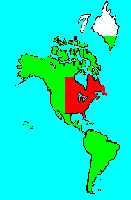SPECIES INFO
Hairy arrow-leaf (Sagittaria pubescens to Sagittaria latifolia ssp pubescens) is found in bogs and shallow water form Nova Scotia west to Wisconsin and south to Missouri and Kansas. This slightly hairy plant will show fuzz on its flower stalk and leaf stems. The flower stem of this lifeform can reach about 2 feet into the air. The basal lobes of the blades are about half as long as the blade.Sagittaria genus is very widespread and is found in temperate and tropical regions around the world. There are about 40 species in this genus. These are perennial aquatic or bog herbs with enlarged, fibrous roots. The leaves are on long petioles or can be reduced to bladeless phyllodia. There are 27 species and eight subspecies growing in greater North America.
Water Plantain Family (Alismaceae equal Alismataceae) is small family with approximately one hundred species. These species are spread across about 11 genera. There are five genera with 37 species growing in greater North America including Greenland, Puerto Rico, and the Virgin Islands. These are perennial or annual swamp or aquatic herbs. Most species have medium sized flowers with 3 petals.
Order Helobiae is a mixed assemblage of mostly aquatic plant families. Included here are the pondweeds, Najas, frog's-bit, eel-grass, and water plantains (Sagittaria). This is an arbitrary collection of families used primarily to reduce the number of orders. Some species are totally submerged while others live in shallow water with leaves and flowers above the water line. Some species have both submerged and floating leaves.
Monocots are a large group of plants usually characterized by having leaves with parallel veins and a seed with a single shell. Most flowers are created with multiples of three. In the older botany texts, the Monocots were considered more primitive than the Dicots. However, many recent authors have placed the Monocots as an offshoot of the primitive Dicots. Here they are placed before the Dicots.
In l951 Lawrence at Cornell published a very detailed plant taxonomy for vascular plants. His taxonomy is very useful as he provided both a detailed explanation and also covered many genera. In the l990s Cronquist published a new plant taxonomy that improved the older taxonomy based on new knowledge. About the same time, Dahlgren published a different taxonomy.
Seed plants (Phylum Embryophyta) are generally grouped into one large phylum containing three major classes: the Gymnosperms, the Monocots, and the Dicots. (Some scientists separate the Gymnosperms into a separate phylum and refer to the remaining plants as flowering plants or Angiospermae.)
For North American counts of the number of species in each genus and family, the primary reference has been John T. Kartesz, author of A Synonymized Checklist of the Vascular Flora of the United States, Canada, and Greenland (1994). The geographical scope of his lists include, as part of greater North America, Hawaii, Alaska, Greenland, Puerto Rico, and the Virgin Islands.
Kartesz lists 21,757 species of vascular plants comprising the ferns, gymnosperms and flowering plants as being found in greater North America (including Alaska, Hawaii, Greenland, Puerto Rico and the Virgin Islands.
There are estimates within the scientific world that about half of the listed North American seed plants were originally native with the balance being comprised of Eurasian and tropical plants that have become established.
Plant kingdom contains a large variety of different organisms including mosses, ferns, and seed plants. Most plants manufacture their energy from sunlight and water. Identification of many species is difficult in that most individual plants have characteristics that have variables based on soil moisture, soil chemistry, and sunlight.
Because of the difficulty in learning and identifying different plant groups, specialists have emerged that study only a limited group of plants. These specialists revise the taxonomy and give us detailed descriptions and ranges of the various species. Their results are published in technical journals and written with highly specialized words that apply to a specific group.
On the other hand, there are the nature publishers. These people and companies undertake the challenging task of trying to provide easy to use pictures and descriptions to identify those species.


